Introduction
Navigating the complexities of Level 2 Autism requires a deep understanding of its unique challenges and the substantial support needed to foster the well-being of affected children. This article delves into the key symptoms, including limited verbal communication and difficulty in social interactions, and explores the significant impact of sensory sensitivities and restricted behaviors. Highlighting the importance of early diagnosis and tailored educational strategies, it stresses the necessity of a collaborative approach involving educators, therapists, and caregivers.
By examining the critical role of effective communication systems and early interventions, this comprehensive guide aims to empower parents and advocates, ensuring that children with Level 2 Autism can thrive in supportive and inclusive environments.
Key Symptoms of Level 2 Autism
Level 2 Autism, part of the autism spectrum disorder (ASD), involves significant challenges in social communication and behavioral patterns that necessitate substantial support. Key symptoms include limited verbal communication skills, difficulty engaging with peers, and struggles in understanding social cues. These young individuals often have a strong desire for interaction but face obstacles in initiating or maintaining conversations.
Dr. David (Dan) R. Offord, a renowned psychiatrist for young people, emphasized the importance of ensuring fair opportunities for individuals with disabilities. He believed that engaged, peaceful, and well-supported participation in school, home, and leisure activities is crucial for mental health and equity. For individuals with autism, acknowledging their unmet needs and the strengths they contribute to their communities is essential. Reducing chronic stress sources and providing caregivers with necessary resources can significantly impact their well-being and development.
The International Autism Coordinating Committee (IACC) highlights the fractured landscape of autism support, advocating for evidence-based practices to improve outcomes. Autistic individuals, particularly those with simultaneous emotional and behavioral challenges, are at high risk of social exclusion. Effective communication systems, such as Augmentative and Alternative Communication (AAC) tools, can play a vital role in supporting these individuals. AAC encompasses a range of techniques, from manual signs to advanced speech-generating devices, assisting young individuals in communicating more effectively and independently.
Participating in significant social activities and having access to strong communication systems are essential in ensuring that autistic individuals can flourish and that their caregivers receive proper support.
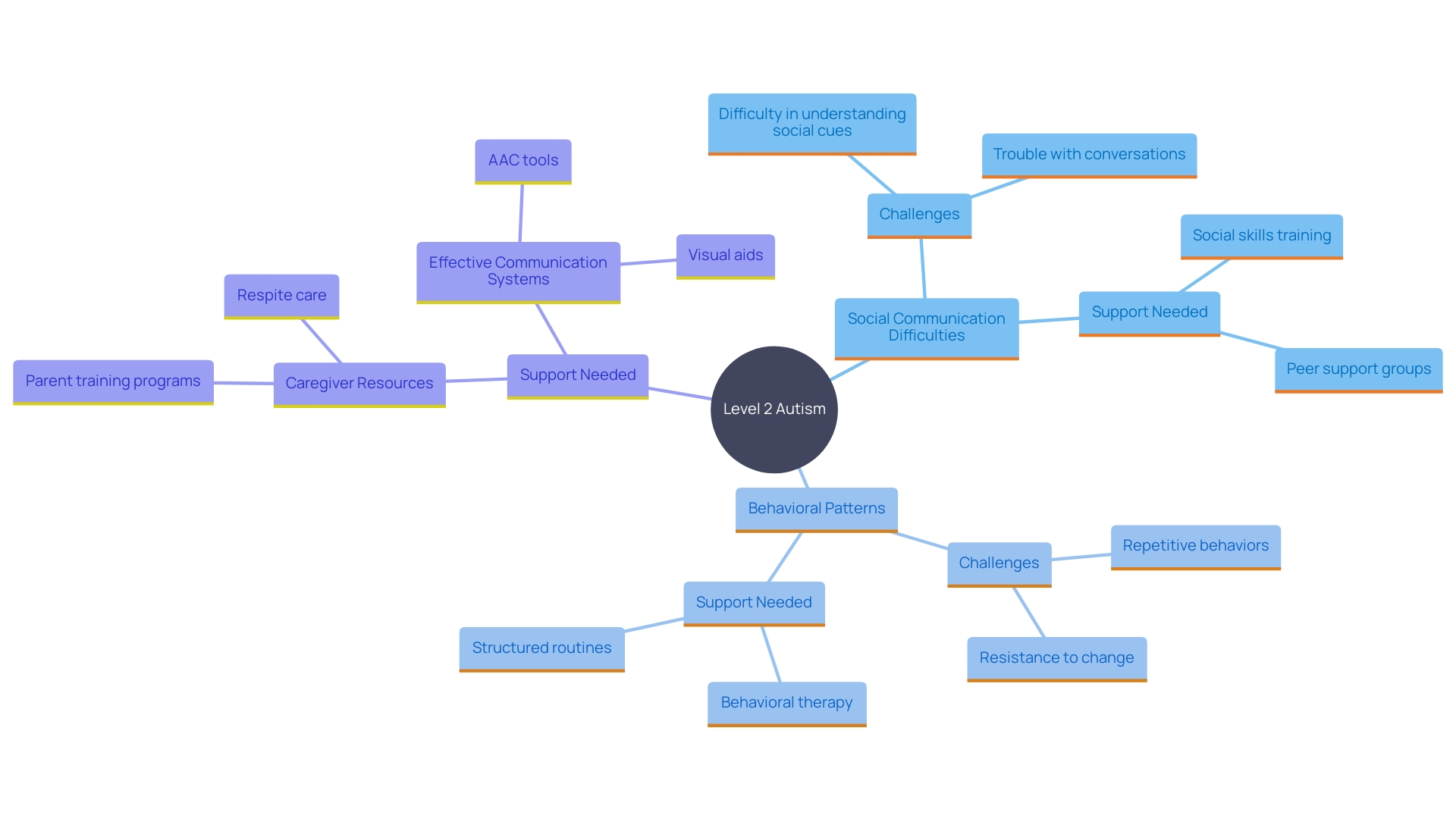
Social Communication Challenges
Children with Level 2 Autism often experience substantial challenges in social communication. They may struggle significantly with both verbal and non-verbal interactions, which includes difficulties in maintaining eye contact, interpreting facial expressions, and using body language effectively. These struggles can manifest in behaviors such as not responding when their name is called or appearing aloof during social interactions. This disconnect can lead to frequent misunderstandings with peers and adults, sometimes resulting in social isolation. As Dr. David (Dan) R. Offord emphasized, ensuring that these young individuals are supported in their school, home, and community environments is crucial. A fair and inclusive environment recognizes their unique needs and strengths, reduces chronic stressors, and provides caregivers with the resources necessary to foster healthy development and well-being. 'Involving autistic youth in significant daily social engagement is crucial for their mental well-being and overall fairness in society.'.
Restricted and Repetitive Behaviors
Restricted and repetitive behaviors are a significant characteristic of Level 2 on the autism spectrum. These behaviors often include repetitive movements such as hand-flapping or rocking. There is also a strong need for routines, and any disruption to their environment or daily schedule can cause considerable distress. Children might show intense interests in specific topics or objects, often focusing on these interests to the exclusion of other activities. As Dr. David Offord emphasized, recognizing and addressing the unique needs of young individuals, including those with disabilities, is crucial for their mental health and overall development. Ensuring that caregivers have the necessary resources is vital for supporting healthy development and family well-being.
Sensory Sensitivities and Adaptability Issues
Children with Level 2 Autism often exhibit significant sensory sensitivities, which can manifest as either heightened sensitivity or under-responsiveness to various sensory stimuli, such as sounds, lights, or textures. These sensory challenges can create overwhelming experiences in environments like schools or busy public spaces, making it difficult for young individuals to navigate daily activities. For instance, a sudden loud noise or bright light can lead to severe discomfort or even distress, affecting their ability to participate in routine tasks.
Moreover, these young individuals may also face considerable difficulties with adaptability. Transitioning from one activity to another or coping with changes in routine can be particularly challenging. This lack of flexibility can disrupt their daily lives and create additional stress for both the young ones and their caregivers. Comprehending and tackling these sensory and adaptability challenges is essential for creating effective support strategies that allow youngsters with Level 2 conditions to flourish in different environments.
Educational Considerations and Support Needs
Comprehending the learning requirements of young individuals with Level 2 developmental disorder is essential. These youngsters often gain advantages from customized educational approaches that accommodate their distinct learning preferences. Support may include specialized teaching methods, social skills training, and the use of visual aids. Collaboration with educators and therapists can create a supportive learning environment that encourages progress.
‘Navigating Autism: The Early Years’ empowers early childhood educators to confidently and effectively support autistic individuals and their parents. It's designed with the help of parents, professionals, and other educators, offering free, evidence-based information and resources accessible anytime, anywhere. As one attendee observed, the program provided a thorough grasp of developmental disorders and insight into young individuals' behaviors.
Inclusion is a philosophy based on the belief that ALL students belong to their school community and should have access to the same opportunities. The core objective of IDEA (Individuals with Disabilities Education Act) is to prepare students for life after high school, focusing on further education and employment. Early intervention and individualized family service plans are essential, especially since most children are diagnosed around the age of four but show developmental signs earlier.
'According to the IACC (Interagency Autism Coordinating Committee), collaboration and communication across federal agencies and the community of individuals with developmental disorders are key to accelerating progress in research and services related to these conditions.'. This committee includes officials from various federal agencies, autistic adults, parents, advocates, researchers, and providers, working together to improve outcomes for individuals on the autism spectrum.
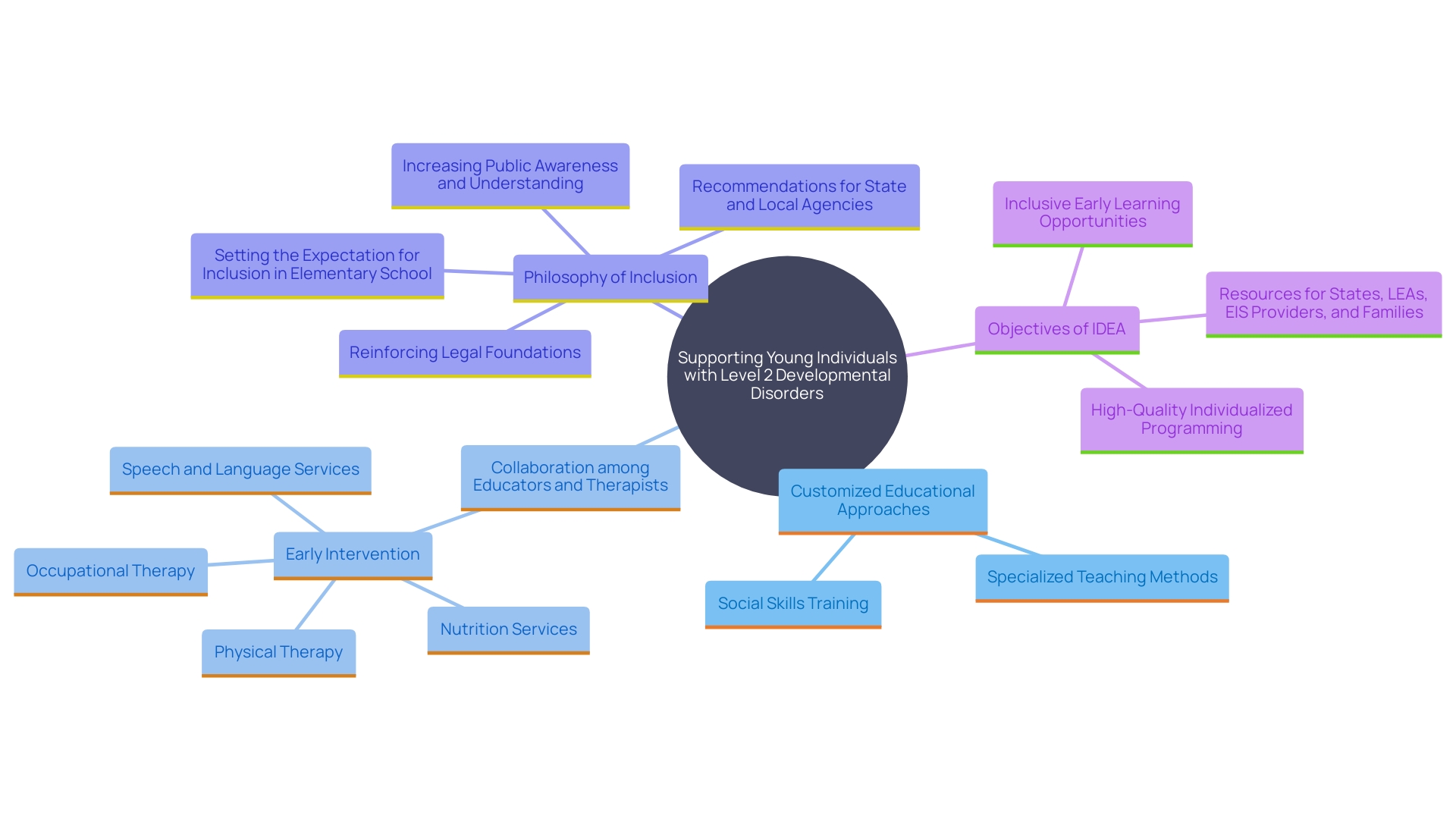
Diagnosis and Assessment of Level 2 Autism
Diagnosing Level 2 Autism requires thorough assessments by healthcare professionals, including developmental screenings and behavioral evaluations. A timely diagnosis is crucial for starting effective measures and assistance, significantly impacting a young person's development and quality of life. Nevertheless, a recent report by Child of the North and the Center for Young Lives emphasizes a crisis in autism assessment, indicating that thousands of children are waiting months or even years for essential health and education assistance. 'This delay in diagnosis and assistance can lead to poor long-term outcomes, such as increased mental health issues and higher risks of school exclusion.'. The report advocates for a 'needs-led' approach, emphasizing early identification and faster support without waiting for a formal diagnosis. According to the IACC, which works to improve coordination in autism research and services, early and accurate diagnosis is the first step in addressing autism, underscoring the urgent need for timely intervention.
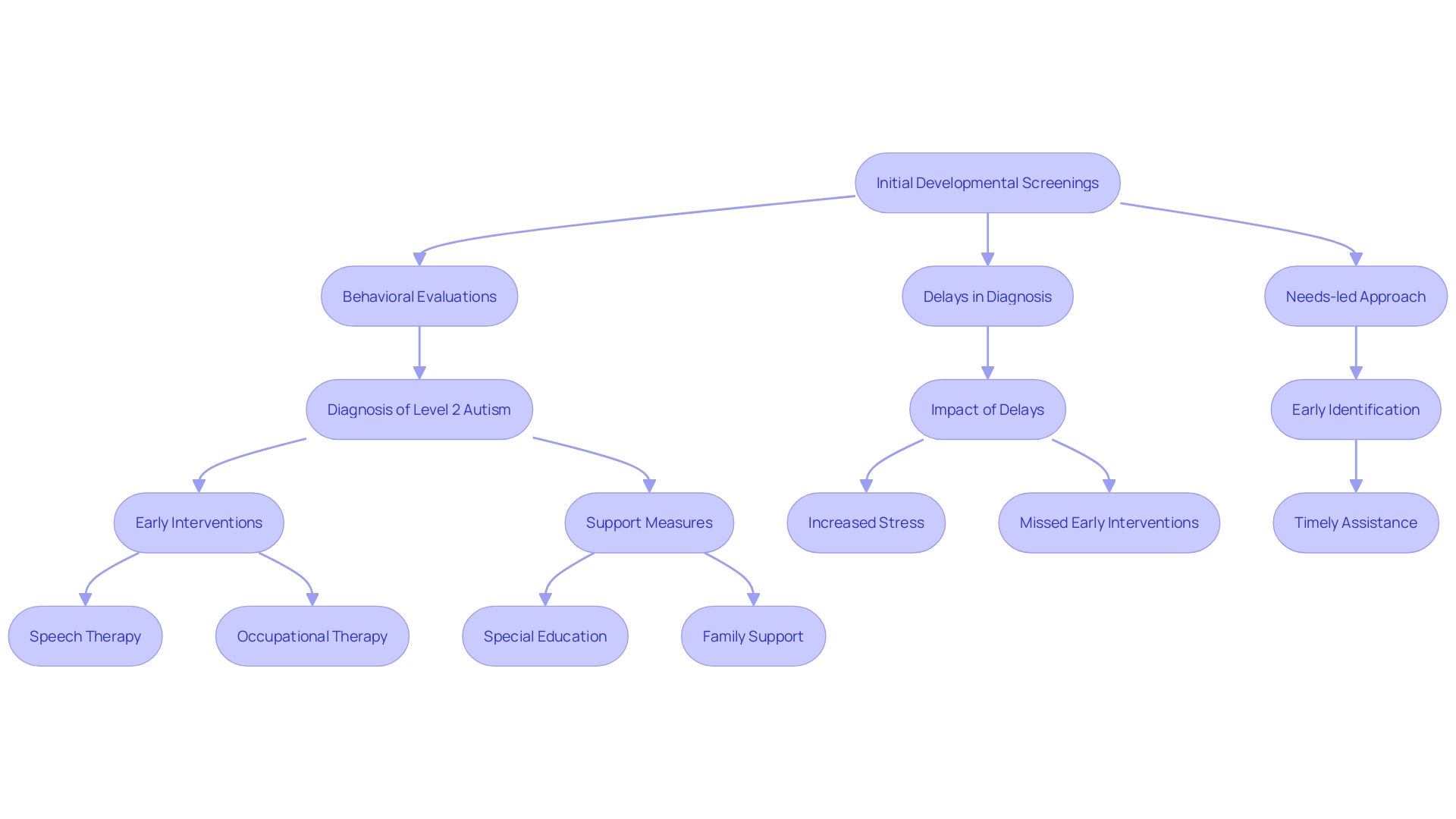
Importance of Early Intervention and Treatment
Timely support is essential for children identified with Level 2 developmental disorder. Timely support can lead to significant improvements in social skills and communication. Programs that emphasize behavior modification, social skills training, and family involvement play a pivotal role. As the Interagency Autism Coordinating Committee (IACC) suggests, coordinated efforts and partnerships within the autism community are vital. Research also indicates that reducing chronic stress and ensuring caregivers have the necessary resources can profoundly impact a young person's development. Dr. David Offord's insights remind us that, similar to ensuring a race is fair, our goal should be to provide equitable support for all young individuals, including those with disabilities. Engaging children in meaningful daily activities within their school, home, and community settings is essential for their mental health and overall well-being.
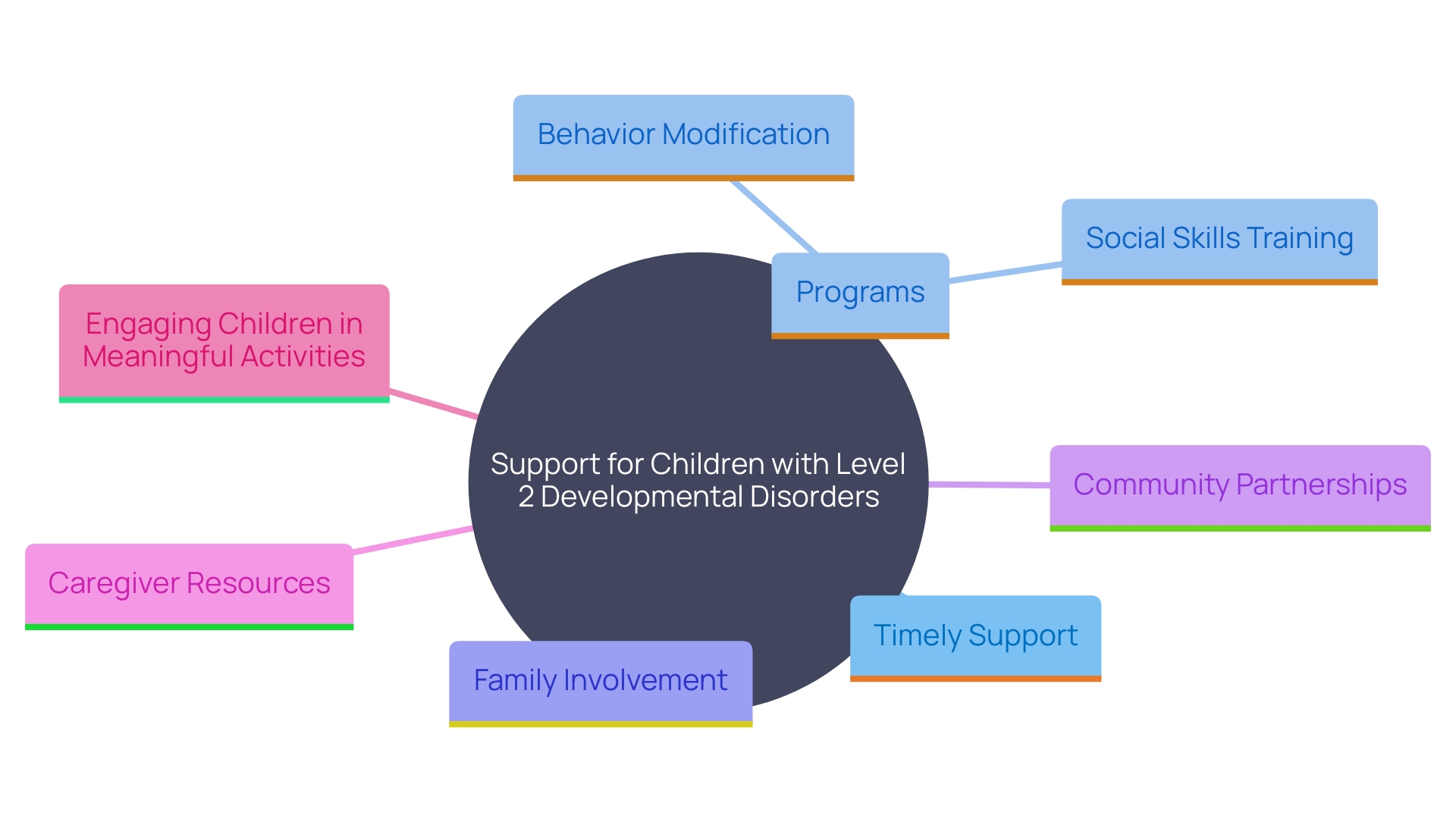
Distinguishing Level 2 from Other Levels of Autism
Identifying the distinctions between Level 2 conditions on the spectrum and other levels is crucial for parents and caregivers. Level 2 autism, characterized by a need for considerable assistance, stands out with significant challenges in social interactions and communication. 'Unlike Level 1, where individuals may require minimal assistance, or Level 3, which involves severe difficulties and significant help, Level 2 presents a unique set of needs that must be understood to provide appropriate care.'.
This distinction is crucial as it directly affects the type and extent of resources and assistance necessary for the young one's development. For instance, a child with Level 2 developmental disorder might struggle with understanding social cues and exhibit repetitive behaviors, which can be confused with conditions like Obsessive-Compulsive Disorder (OCD). Precise identification and customized assistance are essential, as noted by the IACC, which stresses the necessity for coordinated efforts in research and services related to developmental disorders. The committee's work underscores the importance of early identification and intervention to avoid long-term negative outcomes, such as increased prevalence of mental health issues and school exclusion.
Moreover, societal awareness and advocacy have enhanced, yet many adults with this condition remain undiagnosed or misdiagnosed, often not recognizing that their challenges are connected to it. Grasping the typical indicators of this condition can aid in identifying unrecognized instances, enabling improved assistance throughout all age groups. The push for a needs-led approach in autism assessment, as suggested by recent reports, aims to provide timely and effective support, moving away from a purely diagnosis-led system. This approach is pivotal in ensuring that autistic individuals receive the necessary aid without prolonged waiting periods, ultimately supporting their well-being and integration into society.
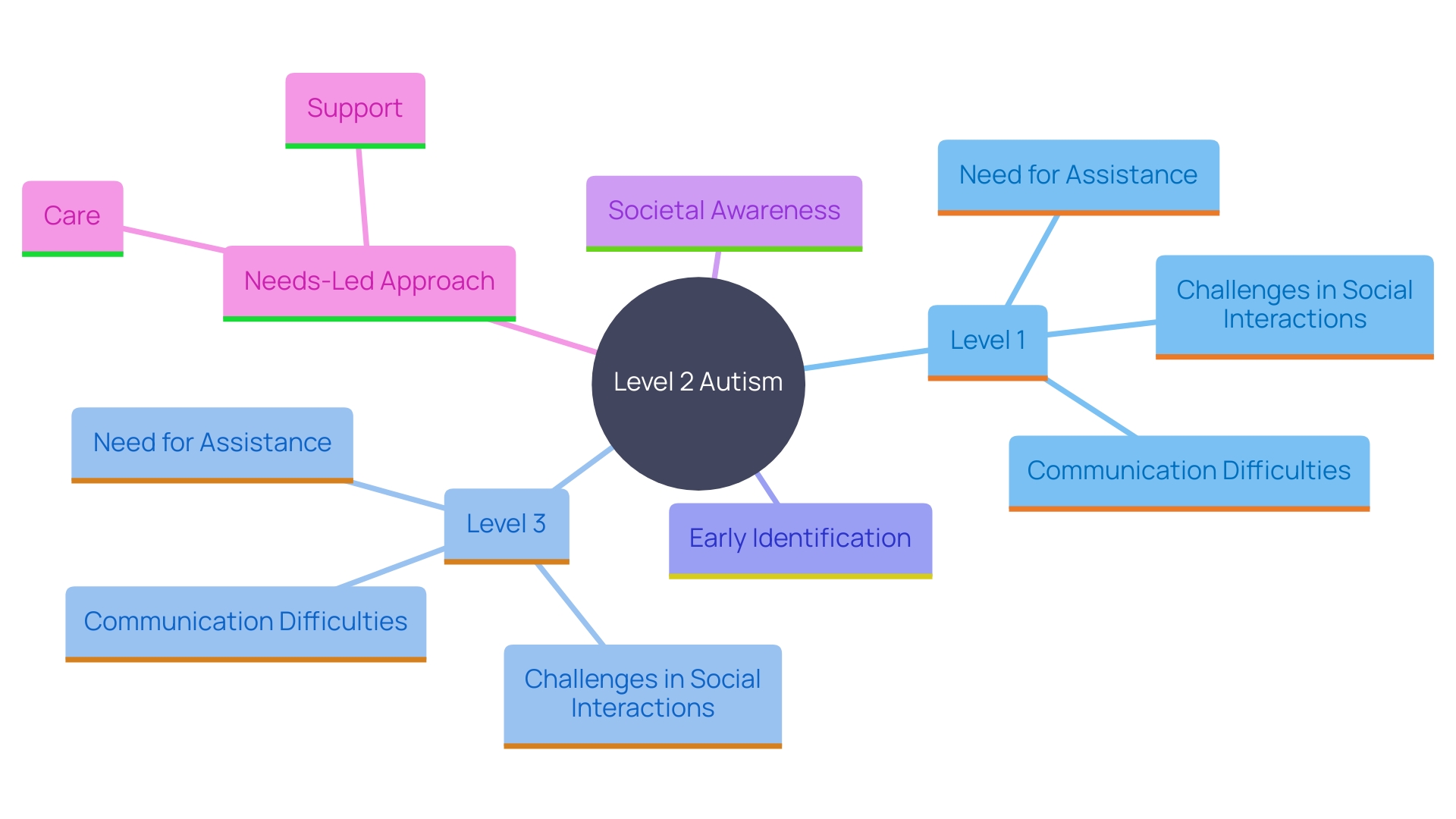
Conclusion
The complexities of Level 2 Autism present unique challenges that require a comprehensive understanding and a proactive approach to support. Key symptoms such as limited verbal communication, social interaction difficulties, and sensory sensitivities underscore the necessity for tailored interventions. Recognizing these challenges is essential for fostering an inclusive environment where children can thrive.
Early diagnosis and intervention are critical in addressing the needs of children with Level 2 Autism. Timely support not only enhances their social and communication skills but also significantly impacts their overall development and quality of life. The importance of collaboration among caregivers, educators, and healthcare professionals cannot be overstated, as it creates a cohesive support system that promotes the well-being of these children.
Furthermore, distinguishing Level 2 Autism from other levels on the autism spectrum is vital for providing appropriate care and resources. Understanding the specific needs associated with Level 2 allows for targeted strategies that can make a meaningful difference in a child's life. The ongoing efforts to improve diagnosis and support mechanisms are crucial in ensuring that every child receives the equitable care they deserve.
Ultimately, empowering parents and advocates with the right knowledge and resources is key to navigating the challenges of Level 2 Autism. By fostering a supportive community and advocating for effective interventions, the potential for children with Level 2 Autism to flourish in their everyday lives can be significantly enhanced.




